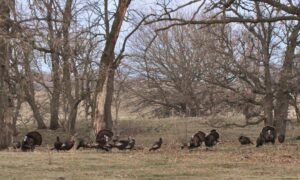Photography courtesy of Lowell Washburn, all rights reserved.
This year’s Spring Turkey Seasons begin April 9th with a special youth only hunt, followed by the first of four regular hunting seasons beginning April 12. The final segment of the five-part, spring season concludes May16. The seasons allows both shotgun and bow hunting, and Iowa hunters may purchase a total of two spring turkey tags.
In spite of a slight decline in statewide turkey populations, Iowa hunters bagged more than 14,600 gobblers during the 2020 spring seasons; an all-time high since mandatory harvest reporting began in 2007. The previous harvest record came in 2016 when hunters bagged 12,173 spring turkeys.
According to DNR Forest Wildlife Research Biologist, Jim Coffey, turkeys were harvested in all of Iowa’s 99 counties during 2020. A total of 536 gobblers were bagged in northeastern Iowa’s Clayton county – the highest number recorded for any county. A total of 135 wild turkeys were harvested in Cerro Gordo.
Biologists speculate that at least part of last year’s record turkey harvest can be attributed to pandemic shutdowns. Home from work and off the job, an increased number of Iowans had time on their hands resulting in a 30 percent spike in hunter numbers. During non-pandemic years, an average of 50,000 Iowa turkey licenses are purchased each spring. Whether or not last season’s “new hunters” return to the woodlands this year remains to be seen.
Famous for its legendary wariness, keen eyesight, and superior hearing, the eastern wild turkey is one Iowa’s most challenging quarries. Regardless of experience, an average of only one in five hunters will successfully fill their tag. In a sport swirling with uncertainties, one of turkey hunting’s few constants is the value of preseason scouting. Just because there were turkeys using a particular woodland last season doesn’t necessarily mean they’ll be there this spring. Considering last year’s surge in hunter numbers and record harvest, scouting local timbers may be more important than ever.
I’ve been doing quite a bit of preseason scouting myself and have encountered some dramatic changes from last year. Although I’ve made a half dozen visits to one of my favorite timbers, I have yet to see or hear a single turkey there. At another favored location, I’ve only seen one turkey so far. Hopefully, some birds will move into both areas as large wintering flocks continue to disperse.
Fortunately, the change in bird distributions seems to be cutting both ways. When I visited a timber that held poor bird numbers during 2020, I was surprised when the daybreak gobbling became so intense, so overlapping that couldn’t tell for sure how many turkeys were actually sounding off. It was the kind of noisy confusion that turkey hunters dream of. Another woodland that had low turkey numbers last spring now harbors a resident population of six toms, seven jakes, and double digit hens. Now those are the kind of changes I can live with.



 Tom Cope
Tom Cope Sue Wilkinson
Sue Wilkinson Susan Judkins Josten
Susan Judkins Josten Rudi Roeslein
Rudi Roeslein Elyssa McFarland
Elyssa McFarland Mark Langgin
Mark Langgin Adam Janke
Adam Janke Joe Henry
Joe Henry Kristin Ashenbrenner
Kristin Ashenbrenner Joe Wilkinson
Joe Wilkinson Dr. Tammy Mildenstein
Dr. Tammy Mildenstein Sean McMahon
Sean McMahon